
views
Trying Gradual Exposure Therapy
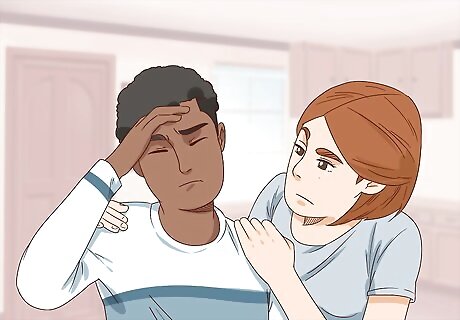
Get help overcoming your phobia if it causes fainting. If you try exposure therapy on your own, you might faint and injure yourself. You could ask a friend or relative to help keep you from falling and hurting yourself. A friend or relative can help if you just get dizzy, lightheaded, or faint for 1 to 2 minutes. However, if you’re prone to longer fainting spells or have ever required medical attention for fainting, work on exposure therapy with a mental health professional. In general, exposure therapy requires a willingness to try being uncomfortable in the hopes of overcoming your fear. By working through your discomfort repeatedly, your fear may lessen over time.

Work through your fear hierarchy at your own pace. Gradual exposure therapy involves working through a fear hierarchy, or a spectrum of triggers organized from least to most intense. Work on tolerating 1 trigger at a time, and move on only when that trigger doesn’t cause anxiety or make you feel like you’re going to faint. Triggers might include seeing your own or someone else's blood, having your blood drawn or, in more intense cases, even thinking about blood. A good way to start is to read or think about blood. Then, look at images and videos and, eventually, get your blood drawn at your doctor’s office. You don’t need to work through the entire list in 1 day. Take all the time you need to get through a step without experiencing symptoms of your phobia. If a step isn’t challenging enough, move on to the next trigger.
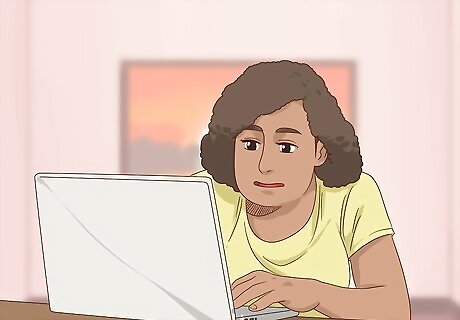
Start by reading about blood tests and donations. Find a medical encyclopedia in print or online. Spend 30 seconds to a minute reading entries about blood, blood withdrawal, and related topics that trigger your phobia. Breathe slowly and deeply as you read, and try to stay relaxed. For example, read an encyclopedia entry on blood withdrawal at https://medlineplus.gov/ency/article/003423.htm. Think or say to yourself, “I’m just reading words about blood. These words can’t hurt me, and I can control my reaction to them.” Gradually increase the length of time that you read, and try to read for 10 to 15 minutes without feeling anxious, dizzy, or lightheaded. If you have trouble reading about blood, start by thinking about or visualizing blood instead.
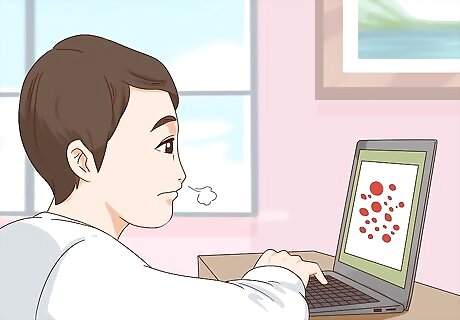
Look at images of dark orange and red dots and blots. Once you can tolerate reading about blood, move on to viewing images that resemble blood. Start with dark orange and red dots, then work your way up to red blob shapes that look more like real blood. As you view the images, control your breathing and practice positive self-talk, such as “These are only pictures of blood, and I am perfectly safe.” When you’re just starting out, look at an image for 10 to 15 seconds. Gradually increase the duration until you can look at images for at least 5 to 10 minutes. Ask a friend or relative to put together a file folder or to print out images that look gradually more like blood. You could also search for exposure therapy videos for hemophobia on YouTube. If you’re working with a mental health professional, virtual reality can be a great way of using visuals to practice exposure therapy, too.

Watch videos of blood being drawn for 10 to 15 minutes. Start by watching a video for 5 to 10 seconds, then gradually work your way up to 10 to 15 minutes. Relax, control your breathing, and remind yourself that you’re only watching a video, that you’re safe, and that you have the power to master this step in your fear hierarchy. Stop watching videos if you experience symptoms and can’t control your reaction. Take a break, then return to looking at pictures of dark orange and red dots, and work your way back up the fear hierarchy. Find videos for hemophobia exposure therapy online or ask a friend or relative to find recordings of blood being drawn. Medical schools post videos on streaming services to demonstrate proper techniques.
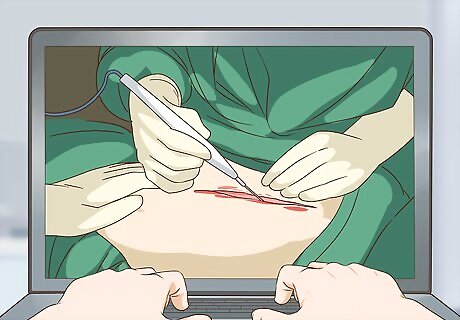
Try watching videos of bleeding cuts and surgical procedures. Eventually, work on tolerating more intense video triggers. Look at a drop of blood caused by a pin prick, a bleeding paper cut and, if you can handle it, a surgical procedure. Watch for 5 to 10 seconds, then go for gradually longer periods until you can tolerate 30 minutes without feeling anxious or lightheaded. Remember to practice relaxation techniques while you watch. Some therapists use surgical videos in exposure therapy. However, plenty of people who aren’t hemophobic have trouble watching an operation. If you can't handle open heart surgery, try watching minor procedures, such as a wound being dressed.

Have your blood drawn when you’re ready. When you’ve worked through your fear hierarchy and can tolerate your triggers, you might be ready to confront your phobia directly. If you’ve neglected to get your blood tested or undergo other medical procedures, schedule an appointment with your doctor. Breathe and encourage yourself with positive self-talk when you go to the appointment. Ask a friend or relative to go with you for moral support. Remind yourself that you’ve worked hard to confront your fear, you have the power to control your reaction, and getting the healthcare you need is your priority.
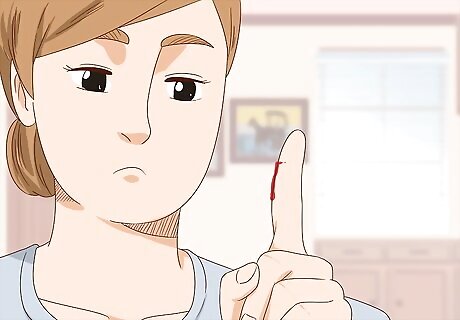
Look at blood in person when the occasion arises. If getting your blood drawn doesn’t bother you, try looking at your blood the next time you get a paper cut. If you’re near someone who gets a minor cut, try to look at their blood. Look at the blood, breathe slowly and deeply, and remind yourself everything is fine. You (or the person who has a paper cut) are safe, and you have the power to keep your reaction in check. If you have trouble looking at blood in person, practice getting through your fear hierarchy again. If you faint or feel lightheaded and dizzy, try adding applied tension therapy to your exposure therapy routine.
Incorporating Applied Tension Therapy

Tense the muscles in your legs, arms, and torso for 15 to 20 seconds. Pump your your muscles by flexing and relaxing them for 15 to 20 seconds. Rest for 15 to 20 seconds, then do a total of 5 pump and rest cycles, or until your face starts to feel flushed. Tensing your muscles increases your heart rate and blood pressure. This sends more blood to your brain, which can help prevent fainting.
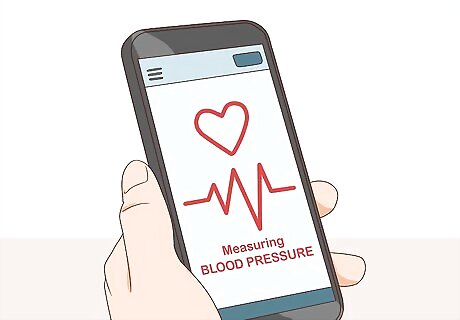
Monitor your blood pressure as you practice, if possible. Pumping until your face feels flush works in a pinch, but using a blood pressure monitor is the most accurate way to check your progress. If you have a home monitoring kit, an app, or a fitness tracker, take your reading before tensing your muscles. Do 5 pump and rest cycles, then take your blood pressure again. During or immediately after tensing, your systolic blood pressure, or the top number, should increase by around 8 mmHg (the unit of measure for blood pressure). Take your blood pressure again 3 minutes after tensing. Your systolic reading should be around 4 mmHg higher than your first measurement. Your diastolic blood pressure, or the bottom number, should remain constant. Do 3 to 5 more tensing cycles if your blood pressure doesn't increase.
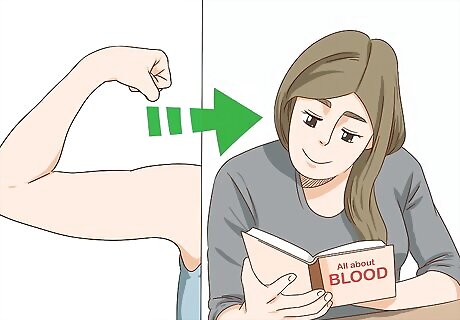
Expose yourself to your fear hierarchy while tensing your muscles. After learning how to tense your muscles, expose yourself to triggers that gradually become more intense. Do 5 pump and rest cycles, then look at the first, least intense trigger. Tense your muscles periodically while looking at the trigger and encourage yourself with positive thoughts. For example, the first step in your fear hierarchy might be to read about blood or blood withdrawal in a medical encyclopedia. Read for around 10 seconds at first, then slowly work your way up to at least 15 minutes. Additional triggers could include looking at red dots, actual pictures of blood, recordings of blood being drawn, and video of a bleeding cut.

Work through your fear hierarchy at your own pace. When you can tolerate the first trigger, proceed to the next. Tense your muscles before and while looking at triggers. Don’t rush yourself through exposure therapy, and move onto the next phase only when you’re ready. If you have trouble with a step, start over and slowly work your way back up the fear hierarchy. Tensing your muscles works in 2 ways. It raises your blood pressure, counteracts the dip in blood pressure that causes fainting. It also helps build confidence. If you start to feel symptoms, you know you have a specific technique that can help keep them in check. If you don’t have success after adding applied tension techniques to exposure therapy, it might be time talk to a mental health professional.
Seeing a Therapist for Hemophobia

See a therapist if you have trouble managing hemophobia on your own. Many people overcome hemophobia on their own using exposure and applied tension therapies. However, some cases are more intense and require a trained professional. If necessary, ask your primary doctor for a referral or look online for a psychotherapist who has experience managing phobias. Hemophobia can directly impact your health, so it’s important to get help if you have trouble overcoming it on your own. In addition to the risk of injury associated with fainting, many people avoid important medical procedures because of their fear of blood.
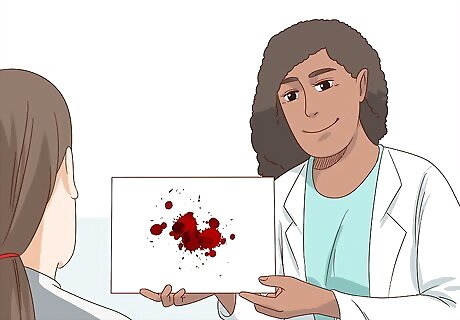
Try exposure and applied tension therapies with their assistance. Exposure and applied tension therapies are the recommended treatments for hemophobia, so your therapist will probably try these techniques first. With their guidance, you might have more success developing an effective fear hierarchy and coping mechanisms. Your therapist might also recommend psychoanalysis or psychodynamic therapy, with are forms of talk therapy designed to identify the unconscious cause of a phobia.
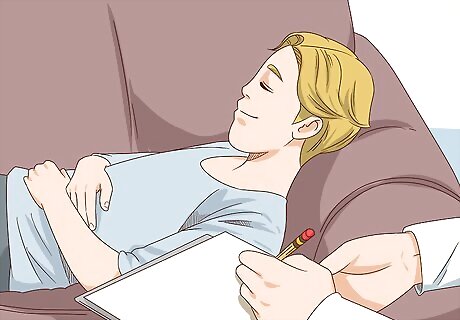
Look into getting clinical hypnotherapy. If traditional exposure therapy is too intense, you might have success with hypnotherapy. Your therapist hypnotizes you, or helps you enter a relaxed state in which your mind is open and focused. Then, they’ll guide you through a form of gradual exposure therapy that involves a series of visualizations. Find a licensed therapist trained in hypnotherapy using the American Society of Clinical Hypnosis search tool at http://www.asch.net/Public/MemberReferralSearch.aspx. Hypnotherapy can help you feel more confident in coping with your phobia.

Discuss short-term medications if you need prompt medical treatment. Therapies for hemophobia can take anywhere from days to months. However, if you need to undergo an urgent medical procedure, you might not be able wait that long. If necessary, consult your therapist and primary doctor about taking a sedative or anti-anxiety medication to get through the procedure. These medications shouldn’t be used as long-term phobia treatments. They can be addictive and, while they can help relieve your symptoms, they don’t address the phobia itself.



















Comments
0 comment